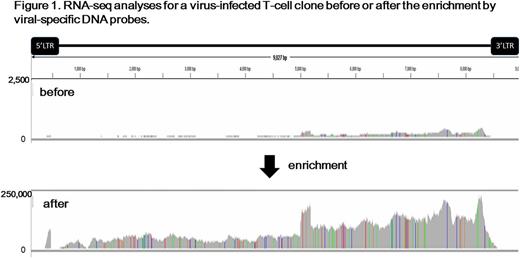Abstract
Introduction
Human T-cell leukemia virus type 1 (HTLV-1) is a retrovirus which causes two major pathologies in infected individuals, Adult T-cell leukemia-lymphoma (ATL) and HTLV-1-associated myelopathy/tropical spastic paraparesis (HAM/TSP). There are tens of thousands of different infected clones in asymptomatic HTLV-1 carriers (AC) and each clone can be identified by the viral integration site. Monoclonal integration of HTLV-1 provirus is observed in the host genomic DNA in ATL cells, suggesting that these originate from a single virus-infected clone. It is well known that Tax and HBZ, encoded in the sense and antisense strands of HTLV-1 provirus, respectively, have the ability to induce oncogenesis. The question is how a certain infected clone, among various different ones, becomes a malignant clone. One hypothesis is that a malignant clone may express viral gene transcripts, associated with oncogenesis, more abundantly than a non-malignant clone. Another hypothesis is that HTLV-1 integration may induce an abnormal transcript in the host cell, such as the aberrant expression of the host gene nearby the integration site or the generation of a chimeric transcript between the virus and the host. To analyze HTLV-1 transcript or explore the presence of virus-host chimeric transcripts efficiently, we aimed to establish a method with higher resolution than the conventional RNA-seq by using DNA probe targeting for the entire HTLV-1 sequence. And then, we applied the protocol to characterize the pattern of transcription from HTLV-1 provirus and analyzed virus-host chimeric transcripts in patients' samples.
Methods
To check the efficiency and possible bias of the highly sensitive viral RNA-seq analysis, we analyzed viral transcript of an HTLV-1-infected clone, TBX-4B. Subsequently, mRNA-seq was performed with PBMCs from 6 AC, 4 HAM/TSP, and 5 ATL patients. After cDNA libraries synthesis, HTLV-1 sequences were enriched by the probe-based capture method as we reported previously for DNA-seq (Miyazato et al, Sci Rep 2016). The enriched libraries were sequenced in an Illumina NextSeq device.
Results
We analyzed HTLV-1 transcript of a virus-infected T-cell clone both before and after the enrichment by viral-specific DNA probes. The proportion of viral sequences within the total number of reads was significantly increased from 0.05% to 80.62% (1600-fold) by the enrichment method. We found that most of the viral regions were significantly and similarly enriched by the additional enrichment step, suggesting the DNA probe-based enrichment of HTLV-1 sequences is applicable to RNA-seq. Next, we applied the protocol to analyze PBMC samples from HTLV-1-infected individuals. The results showed that the level of anti-sense HTLV-1 transcription was significantly higher than that of the sense transcription, not only in ATL patients, which is consistent with previous reports by other groups, but also in AC and HAM/TSP patients. Average proportion of sense and antisense signals were 3.42% and 96.46%, respectively. Even after the enrichment step, tax expression, a sense viral transcript, was undetectable in most of the samples except for one AC and one ATL patient, while an anti-sense transcript HBZ was detectable in all infected individuals. There was no significant difference in the expression level of HBZ between different clinical states. We identified more abundant virus-host chimeric transcripts in ATL samples than in HAM/TSP patients or AC. In ATL cases, HTLV-1 generated chimeric transcripts with the following host genes, HSD17B11, COLEC12, AHSA2, EEF2, TAOK1, KIAA0100, and KIF1B . The presence of abundant chimeric transcripts was validated by RT-PCR.
Discussion
We have established a highly sensitive viral RNA-seq for HTLV-1 transcript analysis. That significantly increased the sensitivity of detection of proviral and chimeric transcripts between virus and the host genome. The result was not consistent with the hypothesis that a malignant clone may express viral gene transcripts more abundantly than a non-malignant clone. Thus, the presence of chimeric transcripts could play a role in cell proliferation and help us reveal the mechanism of clonal selection for HTLV-1-infected cells. We are now going to analyze virus-host chimeric transcripts detected by the high sensitive RNA-seq in more patients' samples to clarify their association with oncogenesis.
Yamano: Daiichi Sankyo: Research Funding; Ono Pharma: Research Funding. Utsunomiya: Celgene: Honoraria; Novartis Pharma: Honoraria; Roche Diagnostics: Honoraria; Japan Blood Products Organization: Honoraria; Daiichi Sankyo: Honoraria; Kyowa Hakko Kirin: Honoraria, Research Funding; Astellas Pharma: Honoraria; Chugai Pharma: Honoraria; Bristol-Myers Squibb: Honoraria; Siemens: Honoraria; Nippon Shinyaku: Honoraria; HUYA Bioscience International: Honoraria; Pfizer: Honoraria.
Author notes
Asterisk with author names denotes non-ASH members.


This feature is available to Subscribers Only
Sign In or Create an Account Close Modal